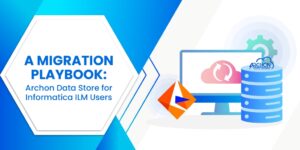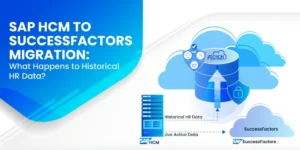Data migration is subject to a host of challenges, especially when seeking a process that is both efficient and timely. Development teams must navigate compatibility issues between systems, ensure system availability, avoid disruption of typical business operations, and take appropriate steps to protect data privacy and security. Complexities mount with the volume of data being migrated, and protecting data integrity is of utmost importance. This involves careful planning, validation, and verification to ensure data accuracy, consistency, and completeness.
Whether you’re looking to eliminate redundancies after a merger and acquisition or need to move your data to a more cost-efficient and modern database, you’ll need to start with a strategic migration plan. Taking a thoughtful approach and thoroughly planning all aspects saves time and costs while preventing risk.
At Platform 3 Solutions, we take a straightforward approach to data migration and walk you through every part of the process. No matter whether your source or target systems are on-prem or in the cloud, you can get peace of mind knowing all key concerns are addressed in a tried-and-true approach.
Step 1: Scope and Definition
For us to build a roadmap for a successful migration, we need to understand your migration story. We’ll work with you to identify and collect information of the source system, such as:
- Number of applications &tech stack
- Number of current databases and objects
- The size of the source databases
- Database objects that should be excluded from migration
- Existing performance issues in the current environment
- Application & database concerns
- Downtime or zero-downtime requirements and other aspects of your migration journey
You’ll also need to run a command that we’ll provide for you to generate a database metadata dump file (in DDL format). that you’ll share with us. Your answers—paired with your expectations for the target system—help us identify the best migration path.
Setting the process of data migration
We’ll analyze source and target compatibility to determine the amount of work required and the level of difficulty in migrating your data to the target system. These results will be discussed with you along with your pre-migration assessment report, which details compatibility and requirements for the migration.
The results from the pre-migration assessment report provide additional details to help define the statement of work (SOW)in scope and complexity. We’ll establish a timeline and estimation of work within this SOW. This document provides details on what needs to be done, what’s in (and out of) scope, and our anticipated efforts. Once the SOW is signed and agreed upon, we move on to step 2.
Step 2: Prepare for data migration
During this phase of the migration process, we turn the information collected in Step 1 into an actionable migration plan. We’ll first gather a little more information and:
- Identify the order of objects and the sequence of execution
- We’ll identify PII data to determine where encryption and masking should be implemented. Sensitive data typically requires a different approach, which may affect the timeline and cost of the statement of work (SOW).
From there, we’ll prepare your migration strategy and account for any downtime or other migration requirements to ensure a smooth migration process. Your migration plan will involve:
- Solution design: We’ll explain the solution to be implemented for your application.
- Application wave planning: We’ll divide all database objects and determine the best strategy for moving them in sprints to use system resources most effectively and efficiently.
- Project planning: Your migration plan is ready! We’ll design a thorough migration strategy for execution.
- Process and templates: A solution overview document is shared with you that reviews how Platform 3 Solution’s tools Archon Analyzer and Archon ETL will be used to perform a system assessment and then perform migration.
Our experts will then perform dry runs of the migration to catch any overlooked dependencies, identify data quality gaps, give delivery managers all applicable insights for estimating effort, and provide proof that the migration process will work as planned. We accomplish this through:
- setting up a test environment,
- conducting data migration trials, and
- validating data accuracy and completeness at the end of the trial.
Step 3: Execute data migration strategy
The next step is the execution of the devised migration strategy. This involves:
- Schema migration (in sprints): The first step is schema-level migration, where all tables and database objects are imported into the target database. This includes the database structure but not the data itself.
- User/group creation: Source users and groups are replicated on the target system to ensure access rules are the same.
- Data migration (in sprints): Data begins to be migrated to the target system in waves.
- Execution of constraints and code objects: Views, procedures, triggers, and other code objects are executed following the data migration.
- Query conversion and tuning: Query conversion and optimization: If you’ve requested conversion of standalone or application queries, this step handles that process, including performance tuning for improved efficiency. Our team can convert these queries to the migrated database format and tune them for better performance if they have existing difficulties in the source system or if they become slow in the new environment.
Measuring the success of data migration
During this stage, we attempt to hit the following benchmarks to track the success of the data migration:
- Migrate all intended data and objects on time without error
- Ensure all migrated data can be accessed by the required services within the agreed benchmark times and can be easily maintained
By this time, we’ve almost finished the migration process. Next, it’s time to check the migration results and validate that everything was completed successfully. This process will start with you receiving a series of post-migration validation reports that show the comparison of the original and current state of objects, data, and users.
These reports ensure that all objects were migrated by showing the source and target object attributes, data hash comparison, connection details, and users, groups, & roles. Even though the count of rows might be the same after migration, data still needs to be checked.
Then, as an option, your team can perform additional testing to determine whether performance, integration, and UAT are subject to any problems while checking query efficiency or database configurations. Our team will complete additional fine-tuning to help with any problems that arise. Whether you choose to perform this testing now or not, there’s another opportunity to run additional tests in Step 4: Final Steps.
Step4: Final steps
The final actions to be taken are all centered around wrapping up the migration, handing off all documents, and cutting off the Platform 3 Solutions team’s access to your environment. We’ll first:
- Complete CDC activities: Change data capture (CDC) and data comparisons are used if there is any live data migration. As the data migration process ends, data is reconciled and cutover is performed with minimal downtime. Complete data reconciliation is achieved before cutting over to the new system.
- Configure HA and DR: After migration, it’s important to make sure high availability and disaster recovery will continue uninterrupted. If needed, additional instances can be set up during this stage for data replication and backup management.
- Perform cutover: Application integration is cut from the old database over to the new database.
- Hand it over to your app team: We cease activity in your instance so your application team can perform performance, integration, and UAT testing and evaluate the downstream flow, upstream flow, and complete ecosystem.
- Await signoff from your app team: We will wait for a signoff from your application team confirming that everything is working as expected before moving to the next action item.
- Repeat until complete: This migration process will be repeated for each life cycle in QA, QC,& Prod.
At this point, we’ll ensure the client is set up for long-term success by walking through best practices the client can take with the migrated data, including:
- Establishing monitoring, observability, and maintenance processes
- Performing regular data audits and quality checks
Results of data migration
And that’s it! You’ll have completed the migration process from start to finish with the help of our team. As a result, you can:
- Improve innovation
- Maintain business-critical operations with an upgraded and optimized database instance
- Increase performance
- Achieve cost-effectiveness
What’s next?
Our team is here to help you with your migration journey, no matter what complications you expect or what concerns there are. Our solutions are designed to make the entire migration process safe with thoughtful considerations taken to optimize resource usage and system load.
Many companies have entrusted our team to support their shift to new technologies and leverage cloud-based or open-source solutions. We can accommodate both application and database migrations along with several source and destination system types. Common migrations across different industries can include:
- Peoplesoft to Workday
- Legacy CRM to Salesforce
- Legacy ECM to Cloud Content Services
- SAP/Oracle to SAP/HANA
- Network Drives to Content Services
- Legacy Database Systems to the Cloud
- IBM DB2 or Microsoft SQL to PostgreSQL or EDB Postgres
No matter where you’re coming from or where you’re headed, our proven migration solutions will get you there efficiently with minimal risk to your business-critical applications.
Reach out to us anytime to tell us your migration needs and get started—we’re here to help
Platform 3 Solutions is a global leader in end-to-end legacy application migration and retirement solutions. Platform 3 empowers secure and seamless transitions of data and applications, eliminates technology debt, and delivers the ROI to invest in technology modernization.



